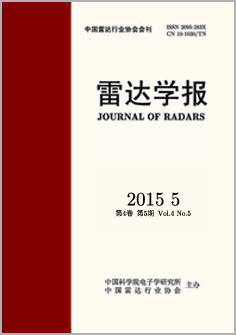- Home
- Articles & Issues
-
Data
- Dataset of Radar Detecting Sea
- SAR Dataset
- SARGroundObjectsTypes
- SARMV3D
- AIRSAT Constellation SAR Land Cover Classification Dataset
- 3DRIED
- UWB-HA4D
- LLS-LFMCWR
- FAIR-CSAR
- MSAR
- SDD-SAR
- FUSAR
- SpaceborneSAR3Dimaging
- Sea-land Segmentation
- SAR Multi-domain Ship Detection Dataset
- SAR-Airport
- Hilly and mountainous farmland time-series SAR and ground quadrat dataset
- SAR images for interference detection and suppression
- HP-SAR Evaluation & Analytical Dataset
- GDHuiYan-ATRNet
- Multi-System Maritime Low Observable Target Dataset
- DatasetinthePaper
- DatasetintheCompetition
- Report
- Course
- About
- Publish
- Editorial Board
- Chinese
| Citation: | Yu Fan, Yuan Jie. A Modified Two-scale Microwave Scattering Model for a Dielectric Randomly Rough Surface(in English)[J]. Journal of Radars, 2015, 4(5): 560-570. doi: 10.12000/JR15067 |
A Modified Two-scale Microwave Scattering Model for a Dielectric Randomly Rough Surface(in English)
DOI: 10.12000/JR15067 CSTR: 32380.14.JR15067
-
Abstract
In this paper, we present a Modified Two-Scale Microwave (MTSM) scattering model to describe the scattering coefficient of naturally rough surfaces. The surface roughness is assumed to be Gaussian in the proposed model so that the surface height z(x, y) can be split into large- and small-scale components by the wavelet packet transform according to electromagnetic wavelength. We used the Kirchhoff Model(KM) and Small Perturbation Method (SPM) to estimate the backscattering coefficient of large- and small-scale roughness, respectively. The tilting effect caused by the slope of large-scale roughness was corrected when calculating the contribution of backscattering to small-scale roughness. The backscattering coefficient of the MTSM comprised the total backscattering contributions of surfaces with both scales of roughness. The MTSM was tested and validated using the Advanced Integral Equation Model (AIEM) for dielectric randomly rough surfaces. The accuracy of the MTSM showed favorable agreement with AIEM, both when the incident angle was less than 30 (i30) and when the surface roughness was small (ks=0.354).
-

-
References
[1] Valenzuela G R. Depolarization of EM waves by slightly rough surface[J]. IEEE Transactions on Antennas and Propagation, 1967, 15(4): 552-557.[2] Ulaby F T, Batlivala P, and Dobson M. Microwave backscatter dependence on surface roughness, soil moisture and soil texture: Part 1-Bare soil[J]. IEEE Transactions on Instrumentation and Measurement, 1978, 16(4): 286-295.[3] Jin Y Q. Theory and Method of Numerical Simulation of Composite Scattering from the Object and Randomly Rough Surface[M]. Beijing: Science Press , 2008: 5-15.[4] Beckmann P A and Spozzochino T. The Scattering of Electromagnetic Waves from Rough Surface[M]. New York: Macmillan Press, 1968: 20-35.[5] Fung A K. Theory of cross-polarized power returned from a random surface[J]. Applied Science Research, 1968, 18(1): 50-60.[6] Fung A K, Li Z, and Chen K S. Backscattering from a randomly rough dielectric surface[J]. IEEE Transactions on Geoscience and Remote Sensing, 1992, 30(2): 356-369.[7] Wu T D, Chen K S, Shi J C, et al.. A transition model for the reflection coefficient in surface scattering[J]. IEEE Transactions on Geoscience and Remote Sensing, 2001, 39(9): 2040-2050.[8] Wu T D and Chen K S. A reappraisal of the validity of the IEM model for backscattering from rough surface[J]. IEEE Transactions on Geoscience and Remote Sensing, 2004, 42(4): 743-753.[9] Ulaby F T, Moore P K, and Fung A K. Microwave Remote Sensing, Vol Ⅱ: Microwave Remote Sensing Fundamentals and Radiometry[M]. London: Addison Wesley Publishing Company Press, 1981: 6-18.[10] Brown G S. Backscattering from a Gaussian distributed perfectly conducting rough surface[J]. IEEE Transactions on Antennas and Propagation, 1978, 26(3): 472-482.[11] Burrows M L. A reformulated boundary perturbation theory in electromagnetism and its application to a sphere[J]. Canadian Journal of Physics, 1967, 45(5): 1729-1743.[12] Wright J. A new model for sea clutter[J]. IEEE Transactions on Antennas and Propagation, 1968, 16(2): 217-223.[13] Burrows M L. On the composite model for rough surface scattering[J]. IEEE Transactions on Antennas and Propagation, 1973, 21(2): 241-243.[14] Mario L. Applied Stochastic Processes[M]. New York: John Wiley and Sons Press, 1996: 55-62.[15] Fang Z B. Stochastic Processes[M]. Beijing: Science Press, 2011: 10-25.[16] Beckmann P. Scattering by non-Gaussian surfaces[J]. IEEE Transactions on Antennas and Propagation, 1975, 21(2): 169-175.[17] Chui C K. An Introduction to Wavelets[M]. New York: Academic Press, 1992: 22-34.[18] Hilton M L, Jawerth B D, and Sengupta A. Compressing still and moving images with wavelets[J]. Multimedia System, 1994, 2(3): 218-227.[19] Nielsen N H and Wickerhauser M V. Wavelets and time-frequency analysis[J]. Proceedings of the IEEE, 1996, 84(4): 523-540.[20] Strang G and Nguyen T Q. Wavelets and Filter Banks[M]. Wellesley: Wellesley-Cambridge Press, 1996: 103-134.[21] Fung A K. Exact Scattering from a Known Randomly Rough Surface[M]. Switzerland: URSI Commission Press, 1974: 2-8.[22] Valenzuela G R. Theories for the interaction of electromagnetic and oceanic waves - a review[J]. Boundary-Layer Meteorology, 1978, 13(1): 61-85.[23] Jin Y Q. Remote Sensing Theory of Electromagnetic Scattering and Thermal Emission[M]. Beijing: Science Press, 1993: 87-102. -
Proportional views



 Submit Manuscript
Submit Manuscript Peer Review
Peer Review Editor Work
Editor Work




 DownLoad:
DownLoad: